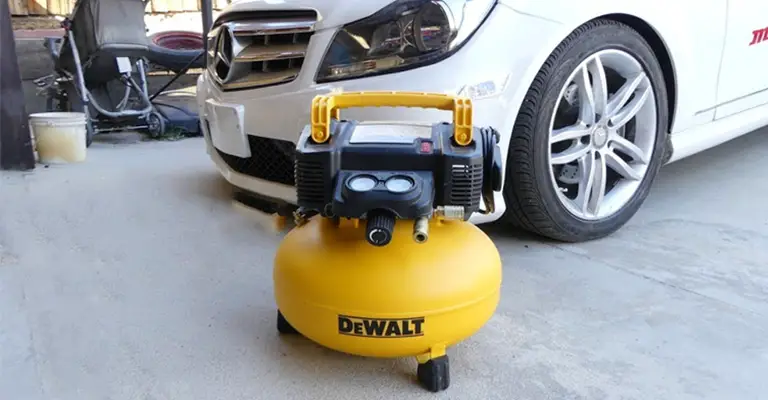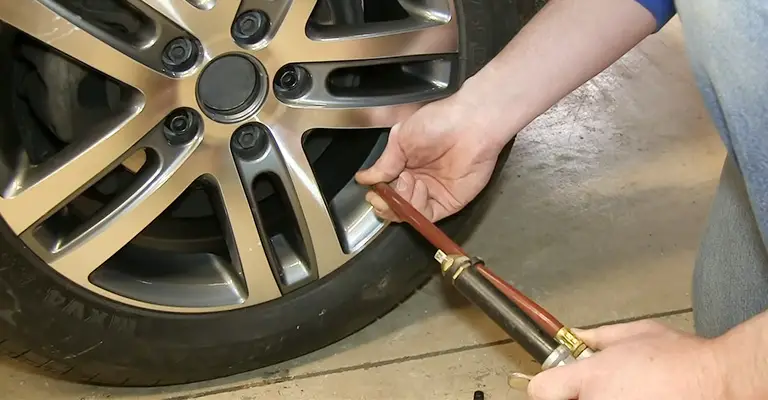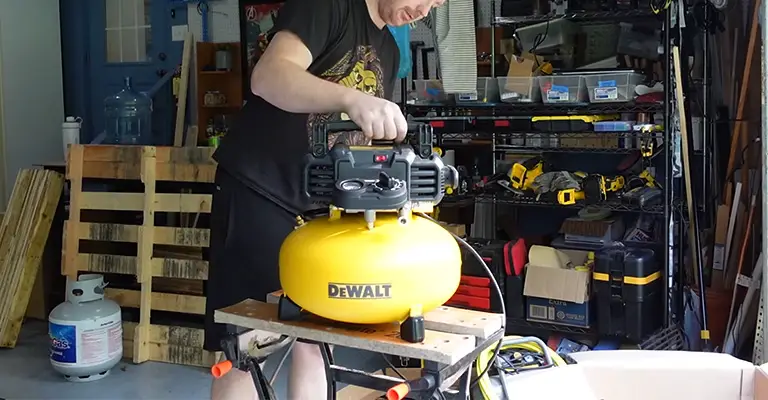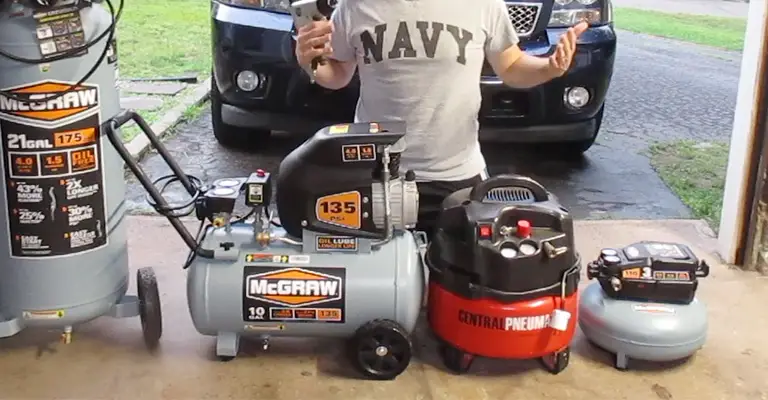Yes, a 6-gallon air compressor should be able to fill a car tire. Most car tires require between 30 and 35 PSI (pounds per square inch) of air pressure, and a 6-gallon air compressor can easily produce enough air to reach that pressure.
However, it’s always a good idea to check your owner’s manual or the tire itself to determine the correct air pressure for your specific car and tires. Now, you might be wondering, can a pancake compressor inflate tires?
Yes, even a pancake air compressor can be used to inflate tires. Pancake compressors are small and portable, making them a convenient option for inflating car tires and other inflatable objects.
To inflate a tire with a pancake compressor, you will need to attach the compressor’s hose to the tire valve and turn the compressor on.
Adjust the pressure as needed to reach the correct inflation level, and then turn the compressor off and remove the hose.
It’s important to ensure you don’t overinflate the tire, as this can cause it to burst. Always consult your owner’s manual or the tire itself to determine the correct air pressure for your specific tires.

How Do I Inflate a Tire?
Inflating a tire is a simple process that can be done using a few basic tools. Here are the steps you’ll need to follow:
- Locate the valve stem on the tire. This is the small, tube-like protrusion on the side of the tire where the air is added.
- Use a tire gauge to check the pressure of the tire. You can usually find tire gauges at any automotive store or a gas station.
- If the tire pressure is low, attach a tire inflator to the valve stem. Most tire inflators are designed to fit onto the valve stem and have a gauge that shows how much air is being added to the tire.
- Use the tire inflator to add air to the tire. You’ll want to add enough air to bring the tire pressure up to the recommended level, which can be found in the owner’s manual for your vehicle or on a sticker inside the driver’s side door.
- Once you’ve added the proper amount of air, remove the tire inflator and replace the valve stem cap. This will help to prevent air from leaking out of the tire.
- Use the tire gauge to double-check the tire pressure to ensure it is at the proper level.
And that’s it! With these simple steps, you should be able to easily inflate a tire. Always check the tire pressure regularly to ensure your tires are always properly inflated.
How Long Will My Tires Take to Inflate?

The amount of time it takes to inflate a tire will depend on a few factors, such as the size of the tire and the amount of air it needs.
It should take a few minutes to inflate a tire using a standard tire inflator. However, it may take longer if the tire is very large, has a slow leak, and needs a lot of air.
It’s also important to note that you should never try to rush the inflation process. Be sure to follow the instructions on the tire inflator and add air slowly and steadily to avoid overinflating the tire.
Overinflating a tire can cause it to burst or fail, which can be dangerous. It takes about 20 to 30 seconds to inflate tires that are inflated at 5 to 6 PSI lower than they should be.
Depending on the size of your inflator or air compressor, it may take between three and five minutes to inflate a fully flat tire.
Will A 3 Gallon Air Compressor Fill A Car Tire?

It is unlikely that a 3-gallon air compressor will be able to fill a car tire. Most car tires require at least 30-35 psi of air pressure, and a 3-gallon air compressor will likely not be able to generate enough pressure to fill a car tire.
Additionally, the size of the compressor’s tank will determine how quickly it can fill a tire, and a 3-gallon tank will likely be too small to fill a car tire in a reasonable amount of time.
What’s a Good Air Compressor for Automotive Use?
Virtually any portable air compressor will do if you simply need to fill up tires on cars, bikes, or wheelbarrows.
A variety of tires, sports equipment, and inflatables can be inflated in the garage using small, portable compressors, also known as air inflators.
Moreover, these compressors are small enough to be stored in your vehicle in a roadside emergency. Household power, 12-volt car plugs, or cordless batteries can power most of them.
There are several compressors in vehicles that provide a continuous supply of air without requiring a tank.
Easy operation is one of the advantages of this type of compressor. The inflator automatically fills the tire to the set PSI by attaching an air hose and setting the pressure.
A typical car, crossover SUV, or pickup truck tire is not very large, and its air pressure is generally between 32 and 36 pounds per square inch.
However, larger tires, including those on service vehicles, farm equipment, and RVs, often require up to 100 PSI. Some portable compressors with a lower operating PSI may have a problem with this.
The 1-gallon tank should be sufficient to fill all your tires in one go if you are just topping off a tire or two with a few pounds of pressure.
For larger-size and heavy-duty tires, portable air compressors of this size, such as those used for pneumatic nailers, are a good choice.
In the case of a completely flat tire, however, several cycles may be necessary to refill the tire completely. It will take longer to change a large tire.
Selecting the Right Size Air Compressor for Filling Tires

When deciding whether or not a compressor can be used to fill your tires, there are a few key factors to consider.
Tank Size
When it comes to filling your tires and running the compressor pump, the size of the air compressor tank will make a difference.
You shouldn’t need more than a 1-gallon tank to top off a couple of tires (adding a couple of pounds of pressure to each tire).
Depending on the size of the tire, it may take several cycles to fill it entirely if you’re filling it from empty. As a result, you will need to wait until the tank has recovered (refilled).
The larger the tank, the less time you’ll spend waiting. Large tires are typically better inflated with 3 gallons and 6 gallons of portable compressors.
It is common for small compressors designed to be kept in vehicles to provide a continuous flow of air, which means that you will never have to wait for the tank to refill.
CFM
It is also important to consider the compressor’s CFM rating. The CFM (cubic feet per minute) measurement is used to measure the flow rate that a compressor can provide. This determines how quickly and efficiently your tire can be filled.
To correctly measure CFM, air pressure needs to be taken into account. As a result, it’s typically measured as x CFM at x PSI. When a compressor can provide 1 CFM @ 100 PSI, it is likely to provide 2 CFM @ 50 PSI as well.
If you don’t mind spending a lot of time filling your tires, you shouldn’t go below 1 CFM at the necessary tire pressure.
For example, suppose your compressor delivers 1 CFM @ 50PSI but only 0.6 CFM @ 100PSI. It won’t take long to inflate a small car tire to 36 PSI, but it may take a while to inflate a big truck tire to 100 PSI.
PSI
An air compressor’s maximum PSI rating may be the most important consideration. Using PSI (pounds per square inch), you can measure the pressure the compressor can deliver.
A tire requiring more pressure than your compressor can provide will not be able to be fully inflated – it will only be fully inflated to the compressor’s maximum pressure.
You cannot put 100 PSI of pressure in a truck tire if your compressor has a maximum operating pressure of 70 PSI.
To ensure correct tire pressure, use a compressor with a maximum operating pressure of at least 10 PSI higher than the recommended tire pressure. Consequently, if your tire needs 100 PSI, you’ll need a compressor that can generate 110 PSI or more.
Equal PSI will also work, but air exchange will slow as you approach maximum pressure, so it might take a while. It is worth noting that most compressors with storage tanks have two gauges: tank pressure and regulated pressure.
When using such a compressor, you should set the regulator knob at least 10 PSI higher than the desired inflation pressure. In any case, even if the tank pressure is at its maximum, you won’t be able to supply adequate pressure.
Final Words
When choosing a compressor, you should ensure that your compressor’s maximum PSI exceeds or at least equals the tire’s recommended inflation pressure.
You’ll be able to accomplish the task quicker and more efficiently based on the remainder of the factors.
If you want to fill up your tires quickly and efficiently, you’ll need a compressor with enough torque to do the job. It is important to strike a balance between power and portability according to your needs.






